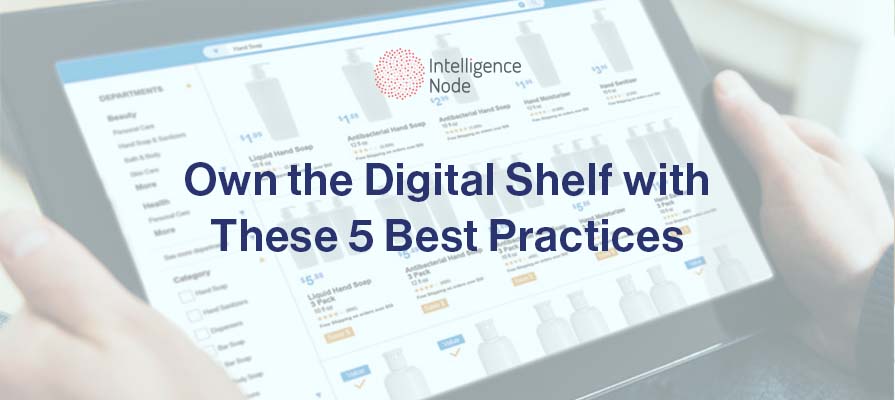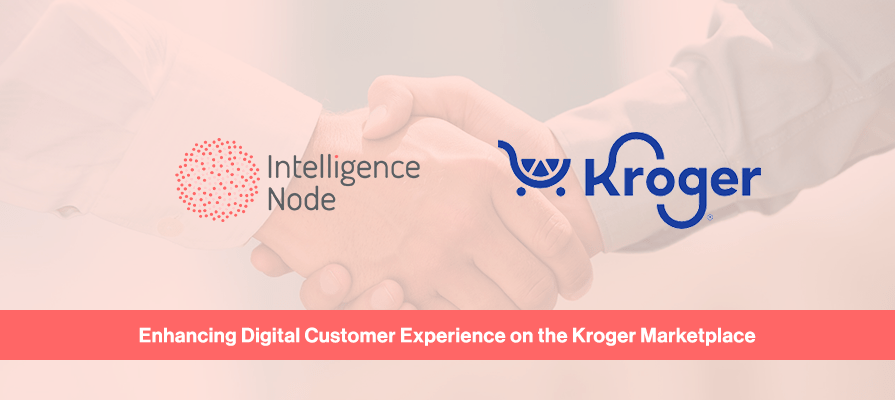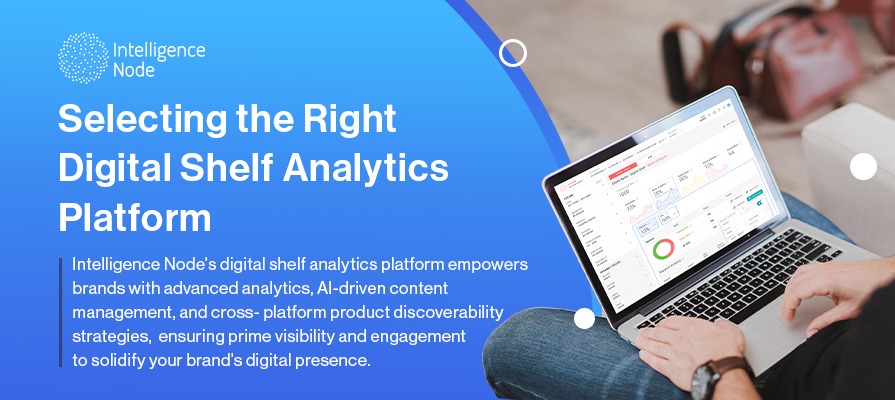The Digital Shelf – What It Is and Why You Need to Optimize for it
The digital shelf is a term used to describe all online channels where your products are being sold. Like product display aisles in a physical store or a supermarket, the digital shelf represents all online touchpoints (websites, marketplaces, in-app stores, search engines) where shoppers might find your products. For decades, brands have used different strategies and marketing budgets to display their products optimally on aisles in physical stores. Similarly, brands need to ensure they are correctly placed on the digital shelf as well, to be visible to online shoppers. But that’s no easy feat. The digital shelf is far more complicated, fluid, vast, and competitive, making it challenging to optimize, maintain high visibility, and maximize the share of search.
Optimizing for the digital shelf involves continuously reviewing product listings and optimizing your product pages across numerous factors. These include SEO-optimized product descriptions, high-quality images, competitive pricing, product availability, and positive reviews and ratings. While a lot of brands and retailers take the easier route to winning on the digital shelf through sponsored ads and significant retail media spending, it is not a sustainable option. It has to be complemented with organic digital shelf optimization for long term growth and success.
The Importance of the Digital Shelf in 2024 and Beyond
Digital retail growth is fast exceeding in-store growth, with a large part of the population now heavily dependent on eCommerce for their shopping needs. In 2024, global eCommerce sales are forecasted to grow by 8.76%, over double the growth rate of physical stores. This pivot to digital retail has brought the digital shelf to the center stage, fast becoming a critical investment area for global brands and retailers.
The digital shelf ranking constantly changes based on numerous factors and can affect a brand’s share of search on Google/Bing search results and marketplaces like Amazon and Walmart. Hence, brands have started leveraging AI-driven digital shelf analytics to optimize their listings, track competitor performance and ranking, and maximize their shelf presence to improve visibility and conversions.
Leveraging Digital Shelf Analytics for Improved Visibility and Conversions
Over 70% of shoppers don’t move past the first page of the first results with a majority not scrolling past the first three results. What this means for brands and retailers selling online is that a lot of their conversions will depend on whether they appear on the first page of search results. The top factors that influence search performance are:
- Product page content (detailed descriptions, right categorization and keywords, correct features)
- Product images (high quality images, multiple images, supporting videos)
- Product pricing (competitive prices)
- Positive reviews and ratings (number of verified positive reviews and ratings)
- Product availability (whether the product is in stock)
Any and all of these factors could influence your search rankings, indirectly influencing your conversion rate. While managing these factors across thousands of listings and multiple platforms is not feasible manually, advanced digital shelf solutions are built to automate these processes and constantly optimize listings to ensure high search performance.
Winning on the Digital Shelf – Setting Up for Long-term Success
Most leading brands today spend exponential amounts of their marketing budget on buying retail media to rank at the top of search results. While this approach may work in the short term, long-term success demands maximizing organic search performance and complementing it with paid media to get the best results without breaking the bank. In this blog post, we set you up for long term digital shelf success with five best practices to grow your share of search and share of shelf organically.
For corporate strategists and retail planners, the digital shelf will be the linchpin of a seamless omnichannel experience. The integration of online and offline retail channels will be more fluid, ensuring a cohesive customer journey from discovery to purchase, irrespective of the platform.
Read Next : What is the Digital Shelf?
What is the Future of the Digital Shelf?
Artificial Intelligence (AI) and machine learning are set to revolutionize the retail sector by providing hyper-personalized shopping experiences. Brands could shape virtual displays that dynamically adapt to individual preferences. Experts can curate product recommendations tailored to each customer’s unique tastes and buying behaviors. This level of customization extends to the digital shelf, where AI algorithms can optimize product placement in real-time. These algorithms are based on browsing patterns and purchase history, making the online browsing experience more intuitive and engaging for consumers.

The future of the digital shelf software also sees the convergence of augmented reality (AR) and virtual reality (VR) technologies. Merchandising heads are exploring innovative ways to leverage AR and VR, offering customers immersive experiences that bridge the gap between online and in-store shopping. Virtual product interactions will become the norm. These enhance online shopping with a tactile and realistic feel, further blurring the lines between physical and virtual shopping. There’s also potential for leveraging blockchain technology to enhance supply chain transparency and authenticity verification on the digital shelf, building consumer trust in brand quality and sustainability practices. As AI and machine learning technologies continue to evolve, the digital shelf will become not only a platform for transactions but a sophisticated, interactive environment that enriches the consumer’s journey, from discovery to post-purchase satisfaction.
In the foreseeable future, the digital shelf is not merely a static online display but a dynamic, tech-infused ecosystem that adapts, learns, and engages with customers on a deeply personalized, efficient level. Embracing these upcoming trends will be instrumental in staying at the forefront of eCommerce innovation and delivering unparalleled shopping experiences to the digital-savvy consumer.
5 Best Practices to Address Key Digital Shelf Challenges
-
#1 . Digital Shelf Challenge – Product is not visible on the 1st page of search or the digital shelf
Almost 90% of online inquiries start with a search. Most shoppers don’t look past page 1 anymore, and almost 80% only look at the first five rows. If your products aren’t ranking on page 1 of the digital shelf, you are likely losing your customers to competitors. To improve conversions, you need to make it easy for your customers to find you. And with the right tools, you can do just that!
-
Best Practice – Optimize your online visibility for improved search rankings
1st-page visibility is critical as it builds credibility and trust. With advanced digital shelf analytics, brands can easily track rankings, compare them with competitors, and optimize listings to rank higher on search engines. Analyze what is working for your competitors and optimize your listings accordingly with the right keywords, attributes, and prices. This will together result in improved visibility.

-
#2. Digital Shelf Challenge – Product is unavailable or out of stock
You have the consumer’s attention, they have looked at your terrific product page and they click on the link to “buy” the product and all of sudden the “out of stock” message pops up. You now have a frustrated consumer who you’ve driven to your competitor’s website.
Out-of-stock products are a major turn-off for shoppers and alienate them from a brand. It is also a big loss for the brand or the retailer as you are essentially turning down a customer who is ready to buy a product from you. As out-of-stock or overstocking of products is a common problem; finding a data-driven solution is the best bet to solve this digital shelf challenge.
-
#3. Digital Shelf Challenge – Incomplete, incorrect or missing product copy & images
To improve your search rankings and visibility requires more than just good products or competitive pricing. Although these two factors are important, your product descriptions, SEO keywords, and quality images significantly contribute to ensuring your products are visible on the first page. Infact, 30% of shoppers abandon their shopping carts due to inaccurate product descriptions.
The reality is that consumers shop online because:
1) they believe they can get a better price and
2) they think they can conduct better research into the product features
So, if your product descriptions are not comprehensive, your consumers will move to the other brands that have more complete information. Let’s try to address this challenge of digital shelf.
-
Best Practice- Include detailed descriptions and high quality product images
Brands and retailers must ensure that their product copy and listings are comprehensive and accurate. With smart digital shelf analytics, they can identify the right keywords to use and enrich their copy with key attributes. They can track competitor rankings and optimize their content by including similar keywords to improve visibility and provide the right descriptions to aid conversions. With Intelligence Node’s product improvement score, retailers and brands can analyze their product performance and improve it immediately.
Parameters Definitions Product code: 80050312 Example score calculations 1) Attribute coverage Number of attribute details available, out of the total number of attributes for the product (category specific). Attribute coverage < 50% results in “failed” coverage (score =1) 17% (assume) Failed = 1 2) Image count Image count < 3 results in “failed” coverage (score =1) 2 Failed = 1 3) Image quality Image quality < median results in “failed” coverage (score =1). The highest image pixel count for every product has been considered in calculating the median of image quality assume 226000 (median = 395875) Failed = 1 4) Length of product info Length of product info < results in “failed” coverage (score =1). The total character count of the product info has been considered for calculating the median of the length assume 409 (median = 626) Failed = 1 Total 4 -
#4. Digital Shelf Challenge – Poor visibility into consumer reviews
Consumers often rely on customer reviews to give them an indication of the experience they might get with the product or the store. Poor consumer reviews can have a direct impact on your conversions and brand identity. A product with more than 5 reviews has a 270% higher chance of being purchased. On the other hand, products without reviews or with poor reviews can discourage shoppers from buying your product and can have a huge impact on consumer sentiment about your products.
-
Best Practice – Listen to what is working for your customers
Consumer reviews are insightful and give you a peek into their sentiments about your product. However, the trend is that most retailers are not tracking customer reviews, much less negative reviews. Lack of visibility to negative customer reviews can severely impact customer’s perception of the brand and the product. Brands and retailers should use customer reviews to improve their product features and attributes. They can leverage user-generated keywords into their product copies to resonate better with their customers. With a ‘rating dashboard’, get an overview of how consumers perceive and rate your products in a summary form and drill down further to any category, brand, or competitor.

Intelligence Node Product Screenshot -
#5. Challenge – No real-time assessment of competitive pricing
In today’s highly competitive eCommerce environment, price remains the most popular reason why shoppers select a product. Sophisticated players like Amazon review their pricing every 2 minutes to ensure they are strategically priced. Without visibility into competitor prices, brands and retailers can lose sales to overpriced products or lose margins by underpricing their products. They might also leave money on the table in the absence of a robust pricing strategy in place.
-
Best Practice – Offer competitive prices by optimizing and reviewing online prices to improve digital shelf performance
When selling online, you are competing with players like Amazon and Walmart, who review their prices multiple times a day. Hence, your pricing strategy needs to be agile and dynamic to keep up with price changes and comparison shoppers. Brands must track competitor prices in real-time and have an automated price monitoring strategy to take advantage of any pricing or assortment gaps left by competitors. Ensure your pricing tools are equipped to offer accurate price recommendations based on multiple factors- competitor prices, market trends, demand, product visibility, etc. Compare and benchmark against exact and similar competitor products with advanced pricing solutions to improve performance on the digital shelf.
Best Practice – Maintain optimum inventory levels of all products to achieve success on the Digital shelf
Deciding the inventory levels for your SKUs cannot be based on product forecasts alone. Comprehensive data analytics solutions help brands understand actual day-to-day demand for top-selling products, the short-term impact of seasonal trends, and real-time competitor sales. With current and historical data, you can predict demand and sales velocity and accordingly optimize your inventory to ensure you are neither overstocked nor understocked.

It’s Time to Own The Digital Shelf
It’s no secret that brands and retailers that leverage technology for customer and competitor data move ahead in the eCommerce race. Amazon, Walmart, and Target are examples of retailers harnessing data and analytics to win the retail race. Brands and retailers need to invest in advanced digital shelf analytics to stay ahead of the curve and thrive in the evolving retail space. Next-gen digital Shelf platforms are rapidly gaining importance in this increasingly competitive arena.
Intelligence Node’s Digital Shelf Analytics Software is powered by proprietary AI and offers real-time insights into your digital shelf performance with 99% accuracy.





